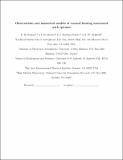Files in this item
Observations and numerical models of solar coronal heating associated with spicules
Item metadata
| dc.contributor.author | De Pontieu, Bart | |
| dc.contributor.author | De Moortel, Ineke | |
| dc.contributor.author | Martinez-Sykora, Juan | |
| dc.contributor.author | McIntosh, Scott | |
| dc.date.accessioned | 2017-08-02T15:30:07Z | |
| dc.date.available | 2017-08-02T15:30:07Z | |
| dc.date.issued | 2017-08-20 | |
| dc.identifier.citation | De Pontieu , B , De Moortel , I , Martinez-Sykora , J & McIntosh , S 2017 , ' Observations and numerical models of solar coronal heating associated with spicules ' , Astrophysical Journal Letters , vol. 845 , no. 2 , L18 , pp. 1-7 . https://doi.org/10.3847/2041-8213/aa7fb4 | en |
| dc.identifier.issn | 2041-8205 | |
| dc.identifier.other | PURE: 250607241 | |
| dc.identifier.other | PURE UUID: 6430287e-8c1b-4eb4-a618-75a8d6ad148b | |
| dc.identifier.other | Scopus: 85028470209 | |
| dc.identifier.other | ORCID: /0000-0002-1452-9330/work/39526513 | |
| dc.identifier.other | WOS: 000407971200006 | |
| dc.identifier.uri | https://hdl.handle.net/10023/11358 | |
| dc.description | This work is supported by NASA (NNG09FA40C; IRIS) and the UK Science and Technology Facilities Council and EU Horizon 2020 research programme (grant No. 647214). | en |
| dc.description.abstract | Spicules have been proposed as significant contributors to the mass and energy balance of the corona. While previous observations have provided a glimpse of short-lived transient brightenings in the corona that are associated with spicules, these observations have been contested and are the subject of a vigorous debate both on the modeling and the observational side. Therefore, it remains unclear whether plasma is heated to coronal temperatures in association with spicules. We use high-resolution observations of the chromosphere and transition region (TR) with the Interface Region Imaging Spectrograph and of the corona with the Atmospheric Imaging Assembly on board the Solar Dynamics Observatory to show evidence of the formation of coronal structures associated with spicular mass ejections and heating of plasma to TR and coronal temperatures. Our observations suggest that a significant fraction of the highly dynamic loop fan environment associated with plage regions may be the result of the formation of such new coronal strands, a process that previously had been interpreted as the propagation of transient propagating coronal disturbances. Our observations are supported by 2.5D radiative MHD simulations that show heating to coronal temperatures in association with spicules. Our results suggest that heating and strong flows play an important role in maintaining the substructure of loop fans, in addition to the waves that permeate this low coronal environment. | |
| dc.format.extent | 7 | |
| dc.language.iso | eng | |
| dc.relation.ispartof | Astrophysical Journal Letters | en |
| dc.rights | © 2017, American Astronomical Society. This work has been made available online in accordance with the publisher’s policies. This is the author created, accepted version manuscript following peer review and may differ slightly from the final published version. The final published version of this work is available at https://doi.org/10.3847/2041-8213/aa7fb4 | en |
| dc.subject | Sun: chromosphere | en |
| dc.subject | Sun: corona | en |
| dc.subject | Sun: magnetic fields | en |
| dc.subject | Sun: transition region | en |
| dc.subject | QB Astronomy | en |
| dc.subject | QC Physics | en |
| dc.subject | 3rd-DAS | en |
| dc.subject | BDC | en |
| dc.subject.lcc | QB | en |
| dc.subject.lcc | QC | en |
| dc.title | Observations and numerical models of solar coronal heating associated with spicules | en |
| dc.type | Journal article | en |
| dc.contributor.sponsor | European Research Council | en |
| dc.contributor.sponsor | Science & Technology Facilities Council | en |
| dc.description.version | Postprint | en |
| dc.contributor.institution | University of St Andrews. Applied Mathematics | en |
| dc.identifier.doi | https://doi.org/10.3847/2041-8213/aa7fb4 | |
| dc.description.status | Peer reviewed | en |
| dc.identifier.grantnumber | 647214 | en |
| dc.identifier.grantnumber | ST/N000609/1 | en |
This item appears in the following Collection(s)
Items in the St Andrews Research Repository are protected by copyright, with all rights reserved, unless otherwise indicated.

